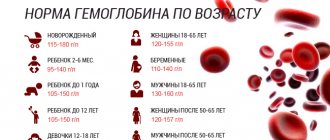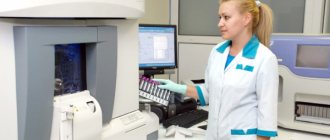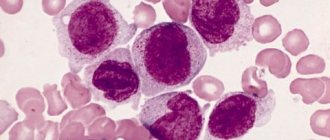Macro- and microelements are necessary for the human body; they participate in all processes of its life. Today we'll talk about hardware. Without this element, which is involved in the processes of hematopoiesis, the formation of hemoglobin and red blood cells, it will be impossible to supply tissues and organs with oxygen. Iron deficiency contributes to the development of very serious diseases. But today I would like to consider the other side of this issue: what will happen if there is an excess of iron? Let's find out what this can lead to and what are the causes of elevated iron levels in the blood.
Iron in the blood is elevated - what does this mean?
The maximum level of this mineral in the blood of a healthy person is 5 g. A significant excess of this norm can lead to unpleasant and sometimes disastrous consequences for the body.
It should be noted that iron is the strongest oxidant. It combines with free radicals. And this leads to rapid aging of the entire organism and its cells. The oxidation of iron with oxygen leads to the formation of free radicals, which contribute to the occurrence of cancer. What are the reasons for increased iron in the blood in women? For example, according to statistics, women who were diagnosed with breast cancer had iron levels much higher than normal.
In men, iron accumulates much faster in the body, causing them to develop various heart diseases, several times increasing the risk of a heart attack at a young age. After menopause, when women stop losing blood every month, they also increase their iron accumulation, which increases their risk of developing cardiovascular disease.
Serum iron level in blood
The normal level of serum iron in men is 10.7 - 30.4 µmol/liter.
For women, the norm of serum iron is less - 9 - 23.3 µmol/liter. This is due to the physiological characteristics of the female body. Women lose iron every month through their menstrual blood.
The indicator has daily fluctuations. The highest level is observed in the morning. There are also fluctuations in serum iron by age:
- the first day after birth - a drop in the indicator;
- increasing by 8-12 years;
- decrease towards puberty;
- increase in the period 20-50 years;
- then a gradual decrease.
In children under one month, the figure is 5.5-19.6 µmol/l.
By the age of eight, the rate rises to 5.8-21 µmol/l.
In the period of 16-18 years, the indicator is 4.9-18.4 µmol/l.
By the age of 20, the rate becomes the same as in adults.
Causes and significance of elevated iron levels
As you already understand, increased iron levels in the blood can lead to unpleasant consequences. If, however, your tests show similar results, you should identify the cause of the increase and try to reduce the level. Let's try to understand the reasons that can lead to an increase in the content of this element in the blood. As practice has shown, uncontrolled intake of multivitamins and preparations containing iron leads to similar results. But there are also diseases that can also lead to similar results.
Iron men
An adult's body should contain approximately 4-5 g of iron.
But today, people who have this element in the normal range are becoming increasingly rare. Especially among city dwellers, increased concentrations of iron are increasingly observed. Is it good or bad?
We won't rust
Everyone knows that “low iron levels are bad.” And only recently they started saying that there is nothing good in the increased content of this element. Indeed, in addition to transporting oxygen, iron regulates the functioning of the immune system, takes part in the functioning of the thyroid gland, promotes the removal of toxins from the body, participates in regeneration processes, improves the condition of the skin, the structure of hair and nails... In short, most processes in our cells occur with the participation of iron. But when there is an excess of it, reactions similar to the formation of rust occur: iron molecules oxidize and damage living tissues.
Where does the surplus come from?
Most of the iron in our body is part of hemoglobin, which is responsible for transporting oxygen in the body. That is why, when a person lacks oxygen, the body tries to compensate by increasing the concentration of hemoglobin. This is what happens to climbers in the mountains. And for residents of cities where the air is saturated with exhaust gases. But climbers descend from the mountains. And city dwellers are constantly experiencing oxygen starvation. Sometimes excess iron in the blood is a sign of liver disease. And then there are people (almost every seventh inhabitant of the planet) who are carriers of a special gene that causes the accumulation of iron. Fortunately, this gene is mostly dormant, so few people suffer from hemochromatosis (the so-called excess iron content). This “defective” gene is also called the “Celtic gene.” It is more common among residents of Scandinavia. Excess iron is more typical for men; due to physiological blood loss, women are less likely to be affected by this problem, but after menopause they begin to “catch up” with men.
Symptoms
Symptoms of excess iron are similar to those of hepatitis - icteric discoloration of the skin, sclera, as well as the palate and tongue, itching, enlarged liver.
In addition, the heart rhythm is disturbed, people look pale and lose weight. Pigmentation is also possible in places where it should not be by definition, for example on the palms, in the armpits, in places of old scars. But in order to make an accurate diagnosis, a biochemical blood test is required
Most iron accumulates in the liver, pancreas, and heart muscle, which ultimately causes changes in the organ itself: hepatitis, liver cirrhosis, diabetes mellitus, diseases of the joints, nervous system, cardiac pathologies, even sudden cardiac arrest.
Excess iron complicates the course of Parkinson's and Alzheimer's diseases and can provoke intestinal, liver, and lung cancer. Rheumatoid arthritis also often occurs due to excess iron.
What to do
People with highly elevated hemoglobin require a special approach. They should not be prescribed even seemingly harmless ascorbic acid, because this vitamin tends to enhance the absorption of iron.
Excess iron is even more difficult to eliminate than deficiency. Perhaps only the old ancestral method - bloodletting (phlebotomy) - allows you to achieve the desired results and sometimes even avoid medications during treatment.
Abroad, for example, donation is even recommended for people over 40-50 years of age to prevent coronary heart disease. So a person “overflowing” with iron can safely sign up as a blood donor.
Well, the most traditional, but also the surest way to regulate iron levels in the blood is proper nutrition.
important to know
It is believed that iron contained in red meat is absorbed better than iron from plants. It is not always so. For example, regular consumption of celery can restore the balance of this element in the body in a few weeks. Iron from plant foods is better absorbed when combined with animal foods.
Vitamin C and B vitamins contribute to better absorption of iron. So, for example, it is useful to eat an apple in addition to meat if you have anemia, but if you have high hemoglobin, it is better to abstain. If there is a lot of calcium and sugar in food, iron is poorly absorbed. Buckwheat cooked in water (without milk) is much healthier for people with low hemoglobin.
It is best to cook food in a Russian stove, but it can be replaced by an air fryer, which cooks according to the same principle. The dish is heated evenly on all sides, without excess water and oil, which allows you to better preserve the beneficial properties of the food. All this makes food tasty and healthy; it is well absorbed by the body, supplying the maximum of necessary elements. Not only vegetables, but also meat cooked in an air fryer meets the recommendations of nutritionists and helps normalize hemoglobin.
What is serum iron
The correct ratio of all substances necessary for a person is the key to good health. At the same time, iron (Fe) is considered one of the most important metals for the body. This microelement is part of pigment proteins, cytochromes and acts as a coenzyme for many chemical reactions. The body contains about 4-7 mg of iron. In the bone marrow, liver and spleen, Fe is found in the form of intracellular ferritin. Only the plasma concentration of this protein complex is a reliable reflection of metal reserves.
Serum ferritin serves as a kind of “iron depot”, which is used both in case of excess and deficiency of this microelement. In tissues, Fe is in the form of hemosiderin. Serum iron is determined in combination with the transport protein transferrin. This complex is used by the body as needed, while tissue and intracellular reserves remain untouched.
Iron is the building material of the human body
Every cell in the human body is made up of chemical compounds. They are necessary for any process in the human body from growth to development and metabolic processes. The body receives micro- and macroelements through food and water. The concentration of macroelements should not be lower than 0.01%, the share of microelements is up to 0.001%. Iron belongs to the second group.
Despite such a low concentration of the substance, it is extremely difficult to overestimate its importance for the human body. It is included in the composition of proteins and enzymes, without which the full implementation of the processes of respiration, synthesis of nucleic acids, immune defense and metabolism is impossible.
The main part (70%) of the microelement is hemoglobin, which is able to combine with oxygen and carbon dioxide. Due to this, red blood cells are able to saturate tissues and organs with oxygen and deliver carbon dioxide back to the lungs. It should be noted that hemoglobin is the only protein that can attach oxygen. In other proteins, iron ions do not have this ability.
About 26% of the substance is included in hemosiderin and ferritin - these are reserves for the body that are formed in the liver, spleen and bone marrow. The remainder is part of the muscle protein myoglobin, which stores oxygen directly in the muscles.
Reasons if serum iron is elevated in adults
Before we begin to consider the reasons, it is necessary to clarify what the normal level of iron in the blood is for adult women and men. For men over 18 years of age, the norm is 11 – 29 µmol/l, for women – from 6.5 to 27 µmol/l. Minor deviations are not a cause for concern. This may result from improper preparation of the patient for the study or failure to comply with the rules for storing and transporting biomaterial.
If a patient has a very high level of iron in the blood, the doctor will determine a set of additional laboratory and instrumental diagnostic methods. Let's consider the main reasons that can lead to an excess of microelements in the human body.
Cooley's anemia
Cooley's anemia is a hereditary pathology that is accompanied by insufficient synthesis of polypeptide chains in the structure of hemoglobin. As a result, hemoglobin with unstable polypeptide aggregates is included in the composition of red blood cells, which leads to their rapid destruction. The disease is widespread in West Africa and South Asia; in the lowland regions of Azerbaijan, 7-10% of the population suffers from Cooley anemia.
Patients are characterized by increased iron levels in the blood and disruption of the structure of the facial part of the skull due to tissue proliferation. It is possible to modify the skull towards a square or tower shape. Patients have malocclusion and incorrect positioning of teeth. The clinical picture also includes yellowing of the mucous membranes and skin, an enlarged liver and spleen. When the disease manifests at an early age, the child experiences mental or physical developmental retardation.
Treatment tactics for different forms and degrees of pathology differ. Newborn babies with Cooley's anemia need to receive a transfusion of purified red blood cells and the administration of drugs to bind iron and glucocorticoids. This will prevent hemolytic crisis. Patients are advised to take B vitamins and folic acid.
The unfavorable prognosis of the disease in the monozygotic recessive form is due to the high mortality rate of newborn children with pathologies. If the patient has a heterozygous form, then with the correct selection of maintenance therapy, his quality of life does not suffer. Prevention measures involve undergoing genetic testing in partners at high risk of carrying the Cooley's anemia gene.
What is the danger of exceeding the norm?
The consequences of excess iron are very serious. An excess amount negatively affects the work:
- The liver is the filter of the whole body. If you notice the signs in a timely manner and begin treatment, the functioning of the vital organ will normalize. Otherwise, liver cells may be destroyed. This will lead to diseases: hepatitis and cirrhosis, necrosis, inflammation of the gallbladder.
- Kidneys. Excess trace elements are collected in the nephrons. They constantly poison the body. The filtration ability decreases, which provokes the occurrence of diabetes mellitus. Protective functions deteriorate, inflammatory processes develop.
- Impact on the nervous system. The brain suffers, the hypothalamus is overloaded. The head begins to hurt, thinking gradually slows down.
- Muscles. Excess iron causes fibers to break. Pain appears and muscle tone is lost. The heart is also a muscle. Poisoning it with iron can provoke the development of a micro-stroke or micro-infarction.
- Spleen. The main function of the organ is part of the metabolic processes occurring in the body, as well as the synthesis of iron. Gradually, iron is deposited on the walls of the organ, and inflammatory processes develop. They can penetrate nearby tissues.
Changes in nutrient balance during pregnancy are dangerous. Not only the expectant mother suffers, but also the child. From the mother's blood he receives all the substances he needs. Iron is an important component of hemoglobin. But in pregnant women, excess iron can provoke pathology of the placenta, to a greater extent the oxidation of free radicals, mitochondria in the placental cells die. Excess can cause gestational diabetes, which leads to miscarriage and subsequent development of infertility.
To prevent this from happening, blood tests are constantly taken from the expectant mother. Women should take medications containing Fe with caution and monitor the dosage. It is more difficult to treat the consequences resulting from excess iron than from deficiency. Especially if the accumulation in the body has occurred for a long time, or it is a hereditary disease. But if the patient consults a specialist in time, when it is possible to avoid the bitter diagnosis of damage to internal organs, then the prognosis may turn out to be quite favorable.
Symptoms of excess iron in the body
An overdose of iron in the human body is expressed by symptoms that can easily be seen with the naked eye. The color of the skin changes, it becomes brown, weakness and apathy appear.
An increased content of the element in the body is accompanied by signs:
- The sclera, tongue, and palate acquire a yellow tint.
- Weight loss and heart failure occur.
- Iron provokes skin itching and a decrease in blood pressure.
- Changes occur in the liver, spleen, heart muscle, and kidneys. It is in these organs that the microelement accumulates the most.
- Libido decreases, and pain and swelling in the joints appear.
Reasons for the decline in indicators
A decrease in the amount of iron in the blood indicates its deficiency as a result of:
- Insufficient intake from outside food;
- Accelerated destruction and removal from the body.
Causes of low serum iron levels:
- Following strict diets, fasting;
- Dietary disorder;
- Poor nutrition with consumption of large amounts of fast food, processed foods, chips and snacks;
- Hepatitis;
- Pregnancy, mainly its second half;
- Heavy bleeding;
- Iron-deficiency anemia;
- Hidden chronic bleeding (gingival, gastrointestinal);
- Period of menstruation. If a woman donates blood for analysis during menstruation, the indicator will be slightly lower than normal. In this case, it is necessary to retake the biomaterial a little later;
- Malignant neoplasms in the digestive system;
- Chronic pathology of the intestines and stomach;
- Recent surgical treatment;
- Vitamin C deficiency.
Normalization of iron levels in this case is as follows:
- Identifying the cause of this condition;
- Treatment of the underlying disease;
- Elimination of chronic bleeding;
- Use of iron-containing drugs according to indications;
- Recovery after surgical treatment according to the scheme depending on the type of surgical intervention;
- Normalization of nutrition. Restoring the diet. Elimination of harmful foods from the diet. Consumption of foods rich in substances.
If iron has decreased after surgery, during pregnancy or in the postpartum period, then it is necessary to monitor this indicator for several days. Gradually it should normalize. Otherwise, special medications are prescribed (Methotrixate, drugs with estrogens).
Blood test for serum iron - explanation
This laboratory test is prescribed not only for patients with various pathologies, but also for ordinary patients during an annual preventive examination. The degree of iron absorption directly affects the functioning of the entire body, therefore it is very important to periodically check the accumulation of this element. This is especially true for women during pregnancy and breastfeeding.
What does it show
Plasma iron is in a bound state. Diagnosis of anemia is based on determining the concentration of transferrin. The iron-binding ability of serum is reflected by the so-called TIBI index. In order to identify tissue deficiency, the ferritin content inside cells is determined. Any abnormalities identified during a biochemical blood test are grounds for prescribing additional laboratory tests.
How to take it
Considering that early morning is characterized by slightly increased serum Fe, experts recommend checking the degree of saturation with this element a little later. As a rule, plasma testing for iron content is carried out from 8 to 10 am. The test is taken on an empty stomach. The day before blood sampling, you should refrain from eating fatty foods and drinking alcohol.











